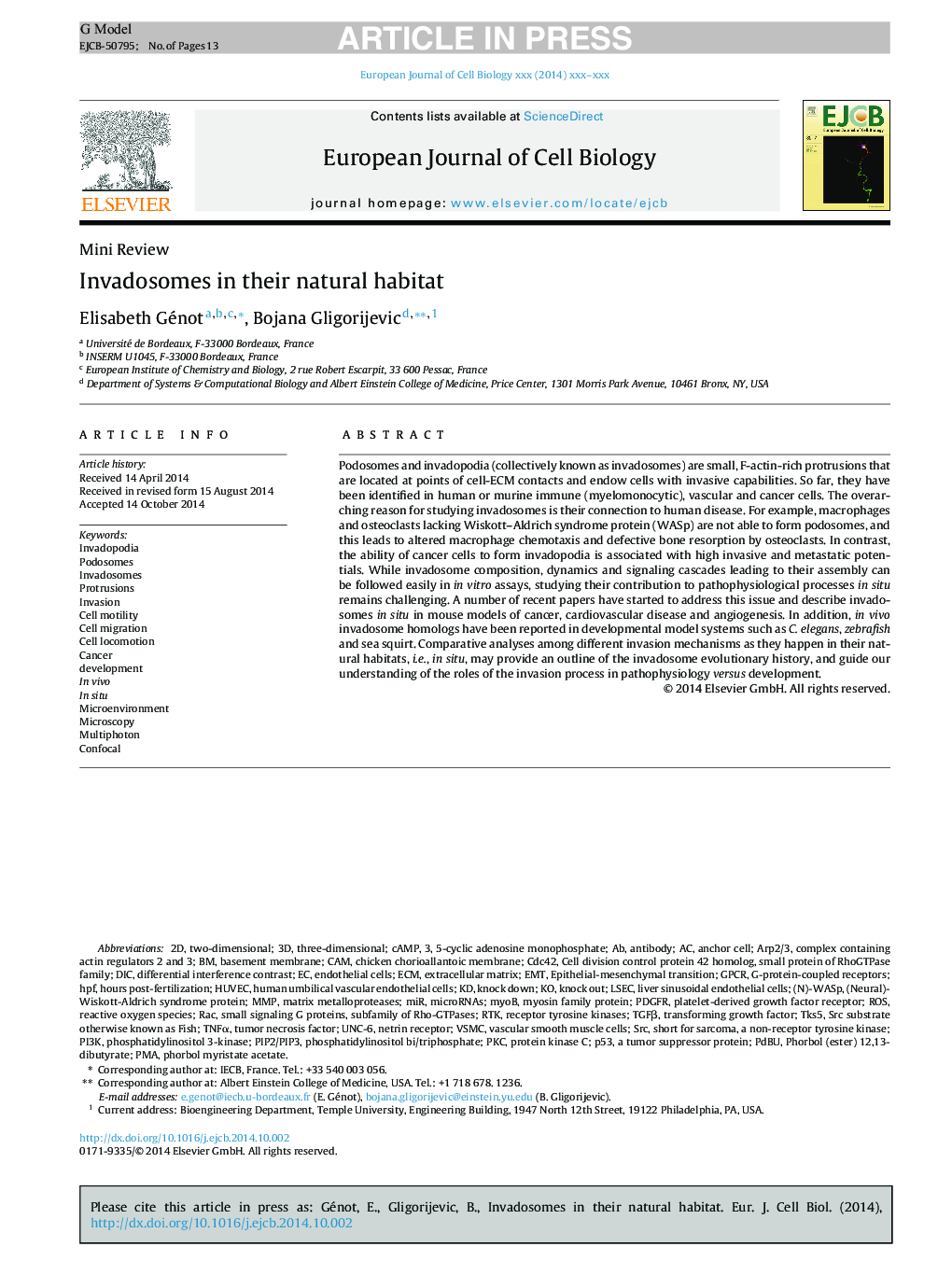| کد مقاله | کد نشریه | سال انتشار | مقاله انگلیسی | نسخه تمام متن |
|---|---|---|---|---|
| 8469900 | 1549684 | 2014 | 13 صفحه PDF | دانلود رایگان |
عنوان انگلیسی مقاله ISI
Invadosomes in their natural habitat
دانلود مقاله + سفارش ترجمه
دانلود مقاله ISI انگلیسی
رایگان برای ایرانیان
کلمات کلیدی
SRCDICInvadopodiaRTKPDGFRCDC42TGFβVSMCMIRPDBuConfocalHUVECECMhpfGPCRTks5PKCThree-dimensionalRACPI3KMMPp53PodosomesTNFαArp2/3 - Arp2 / 3cAMP - cAMPG-protein-coupled receptors - G-پروتئین گیرندهPMA - LDC هاLSEC - lseceROS - ROStransforming growth factor - تبدیل فاکتور رشدCell motility - تحرک سلولیInvasion - تهاجمEMT - تکنسین فوریتهای پزشکیCell locomotion - حرکت سلولیIn situ - در سایتIn vivo - درون تنی یا درونجانداریknock down - دست کشیدنtwo-dimensional - دو بعدیDevelopment - رشدmicroRNAs - ریز آرانایCAM - ساخت به کمک کامپیوترhours post-fertilization - ساعت پس از لقاحCancer - سرطانanchor cell - سلول لنگرHuman umbilical vascular endothelial cells - سلول های اندوتلیال عروق انسانی انسانیVascular smooth muscle cells - سلول های عضلانی صاف عروقیEndothelial cells - سلولهای اندوتلیالLiver sinusoidal endothelial cells - سلولهای اندوتلیال سینوسال کبدیbasement membrane - غشای پایهChicken chorioallantoic membrane - غشای کوریوالانتائی مرغtumor necrosis factor - فاکتور نکروز تومورphorbol myristate acetate - فروبل مریستات استاتPhosphatidylinositol 3-kinase - فسفاتیدیلینواستیل 3-کینازExtracellular matrix - ماتریکس خارج سلولیMatrix metalloproteases - ماتریکس متالوپروتئازهاCell migration - مهاجرت سلولیMicroenvironment - میکرو محیطMicroscopy - میکروسکوپ یا ریزبینknock out - ناک اوتAntibody - پادتَن یا آنتیبادیProtein kinase C - پروتئین کیناز سیProtrusions - پیشانیMultiphoton - چند فوتیونdifferential interference contrast - کنتراست تداخل دیفرانسیلEpithelial-mesenchymal transition - گذار اپیتلیال-مزانشیمیReactive oxygen species - گونههای فعال اکسیژنreceptor tyrosine kinases - گیرنده تیروزین کینازplatelet-derived growth factor receptor - گیرنده عامل فاکتور رشد یافته پلاکت
موضوعات مرتبط
علوم زیستی و بیوفناوری
علوم کشاورزی و بیولوژیک
دانش گیاه شناسی
پیش نمایش صفحه اول مقاله

چکیده انگلیسی
Podosomes and invadopodia (collectively known as invadosomes) are small, F-actin-rich protrusions that are located at points of cell-ECM contacts and endow cells with invasive capabilities. So far, they have been identified in human or murine immune (myelomonocytic), vascular and cancer cells. The overarching reason for studying invadosomes is their connection to human disease. For example, macrophages and osteoclasts lacking Wiskott-Aldrich syndrome protein (WASp) are not able to form podosomes, and this leads to altered macrophage chemotaxis and defective bone resorption by osteoclasts. In contrast, the ability of cancer cells to form invadopodia is associated with high invasive and metastatic potentials. While invadosome composition, dynamics and signaling cascades leading to their assembly can be followed easily in in vitro assays, studying their contribution to pathophysiological processes in situ remains challenging. A number of recent papers have started to address this issue and describe invadosomes in situ in mouse models of cancer, cardiovascular disease and angiogenesis. In addition, in vivo invadosome homologs have been reported in developmental model systems such as C. elegans, zebrafish and sea squirt. Comparative analyses among different invasion mechanisms as they happen in their natural habitats, i.e., in situ, may provide an outline of the invadosome evolutionary history, and guide our understanding of the roles of the invasion process in pathophysiology versus development.
ناشر
Database: Elsevier - ScienceDirect (ساینس دایرکت)
Journal: European Journal of Cell Biology - Volume 93, Issues 10â12, October 2014, Pages 367-379
Journal: European Journal of Cell Biology - Volume 93, Issues 10â12, October 2014, Pages 367-379
نویسندگان
Elisabeth Génot, Bojana Gligorijevic,